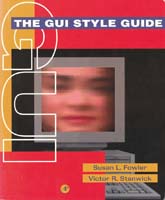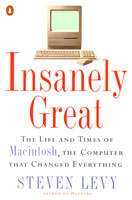|  |
The following is the list of GUI-related books, with reviews and – in some cases
– excerpts:
|  |
| |
 | |  |
|  |
 |   Apple Human Interface Guidelines Apple Human Interface Guidelines
The Apple Desktop Interface
Addison-Wesley, 1987
162 pages
This is the third edition of guidelines for creating interfaces with Macintosh GUI, published in mid-1988. It has been superceded many times. The updated Macintosh Human Interface Guidelines book was released in 1992, then the guidelines were made available freely on the website as PDF,  updated to Mac OS X (as Aqua Human Interface Guidelines), and eventually made compliant with Mac OS X 10.3 Panther, renamed again to Apple Human Interface Guidelines. When compared to this PDF, the original book seems surprisingly short and simple, but that’s just signum temporis, as GUIs back then were also unsophisticated. And that – looking at the recipes and foundations of the initial versions of the first popular GUI, and comparing them with the contemporary interfaces – seems its only use today. updated to Mac OS X (as Aqua Human Interface Guidelines), and eventually made compliant with Mac OS X 10.3 Panther, renamed again to Apple Human Interface Guidelines. When compared to this PDF, the original book seems surprisingly short and simple, but that’s just signum temporis, as GUIs back then were also unsophisticated. And that – looking at the recipes and foundations of the initial versions of the first popular GUI, and comparing them with the contemporary interfaces – seems its only use today.
 |
 |      Aaron Marcus, Nick Smilonich, Lynne Thompson Aaron Marcus, Nick Smilonich, Lynne Thompson
The Cross-GUI Handbook
For Multiplatform User Interface Design
Addison-Wesley, 1994
304 pages
This book was released in 1995 and its main purpose is being a comparison of the popular GUIs: Macintosh, OSF/Motif, NeXTSTEP, OS/2’s Presentation Manager and Microsoft Windows. It tries to do it on various levels: visual, methodological, terminological, giving away free design tips in the process. However, the book has aged rather badly – it won’t be of much use to contemporary UI designers, and is simply too ugly to put on a representative bookshelf.
 |
 |         Kevin Mullet, Darrell Sano Kevin Mullet, Darrell Sano
Designing Visual Interfaces
Communication Oriented Techniques
Prentice Hall, 1994
304 pages
“Designing Visual Interfaces” is not your typical GUI book with a lot of specific guidelines. The authors divided it into several chapters (“Elegance and simplicity,” “Scale, contrast, and proportion,” “Organization and visual structure,” “Module and program,” “Image and representation” and “Style”) and within each of them they present design principles, then proceed to common GUI errors, ending with useful techniques. There’s a lot of screenshots (and, what is commendable, big chunk of those comes from less known operating systems), but also many design examples of real life designs. This makes this 9-year-old, tastefully packaged book still relevant and useful. A very good and highly recommended volume for everyone interested in graphic and interface design.
 |
 |   Jeff Johnson Jeff Johnson
GUI bloopers
Don’ts and do’s for software developers and web designers
Morgan Kaufmann, 2000
584 pages
This is a book intended not for GUI historians (presented here are common Windows and Mac OS interface elements), but rather GUI practicioners and beginner GUI theorists. Described here at length are a couple of dozens of most common GUI blunders (such as using radio buttons where checkboxes are appropriate), with real life examples and design rules. The language is straightforward and accessible, but the whole 600-page book seems a little bit too drawn-out. Nevertheless, it is one-of-its-kind injection of GUI common sense, definitely worth getting familiar with.
 |
 |     Susan L. Fowler, Victor R. Stanwick Susan L. Fowler, Victor R. Stanwick
The GUI Style Guide
Morgan Kaufmann, 1994
407 pages
The book suffers from the same kind of problems as The Cross-GUI Handbook. It’s already almost a decade old, it doesn’t even cover Windows 95, and it wasn’t that pretty to being with. However, contrary to the mentioned counterpart, it is focused more on presenting design ideas than simply pictures. For example, there are chapters on charts and graphs, colours, multimedia, and translating sofware.
 |
 |    William Horton William Horton
The icon book
Visual symbols for computer systems and documentation
John Wiley & Sons, 1994
432 pages
A very good book, explaining in depth all things iconic: from history and theory of the icon design, through various classifications of icons, to development and testing. Hundreds of icons serve as an example in the book and on the attached diskette (650 KB). What’s impressive is that they are not just lifted from various GUIs, but drawn by author especially for this occassion (however, the book also contains various real life case studies). Impressive and inspiring, even 10 years after the publish date.
 |
 |        Steven Levy Steven Levy
Insanely great
The life and times of Macintosh, the computer that changed everything
Penguin Books, 1995
312 pages
This is Yet Another Macintosh Story™ – sure, it flows quite nicely, but doesn’t really contain much more than any other book or good website on this topic. Why am I listing it here then? Two things: its first 100 pages, smoothly going from Memex to Apple Lisa, seem a very accessible introduction to GUI history, and the book ponders a lot about influence of mouse-driven computers on our everyday’s lives. “Insanely great” might not be the deepest book on the subject, but it should do well during a relaxing Sunday porch session, especially if you’re just starting getting to know the fascinating history of GUIs.
 |
 |        Steven Johnson Steven Johnson
Interface culture
How new technology transforms the way we create and communicate
Harper, 1997
264 pages
An interesting exercise in juxtaposing interfaces with historical and contemporary works of art (literature, architecture, paintings), and trying to define and predict cultural aspects and influences of interface design. This is quite a different read than all the other, more technical volumes presented here, and goes way beyond GUIs. For those wishing to expand their horizons, this could be a demanding, but satisfying detour.
 |
|  |
| |
|
 Home
Home 


 Home
Home 